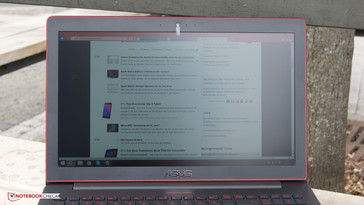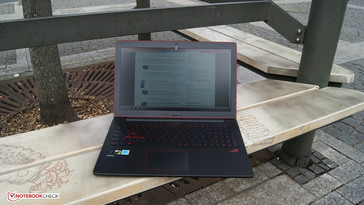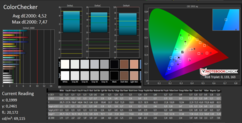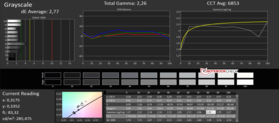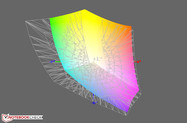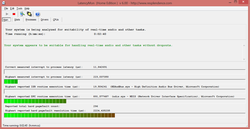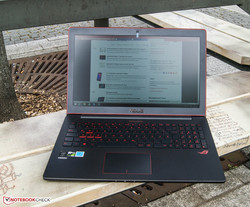Asus G501JW (FHD) Notebook Review

For the original German review, see here.
Recently we had the 2000-Euro (~$2442) model of this series in our test lab. The US model of the G501JW with 4K display and very fast PCI-e SSD with a capacity of 512 GB currently costs about $1999. Now, we also want to scrutinize the cheaper model available for 1400 Euros (~$1569) in Europe. We mainly focus on the necessary compromises and which of these are acceptable for everyday gaming and multimedia use. What had to be omitted for a price of 1400 Euros (~$1569)?
Obviously, cuts had not been made with performance-relevant components, namely processor and graphics card. There is still an Intel Core i7-4720HQ quad-core processor and an Nvidia GTX 960M in our test model. RAM is only 8 GB, but it still works in dual-channel mode. The storage devices became smaller and bigger. The capacity of the fast storage decreased from 512 GB to 128 GB. However, an additional 1 TB HDD was incorporated. Those who still hope for a UHD display will be disappointed. Nevertheless, our Asus G501JW features a decent Full HD display.
Please refer to the previous test for aspects which remained the same (case, keyboard, etc.). We will cover what has changed here. In addition, we will compare our test model to other notebooks of its category.
Display
Let's cover the apparent changes in the configuration first. The manufacturer incorporated a matte Full HD display with a resolution of 1920x1080 pixels. While the resolution is lower, manufacturer and IPS technology remained the same. Due to a matte surface, gloss reflections are not disturbing. The average brightness increased by 20 cd/m² to a quite good 337 cd/m². The contrast is significantly better, too and it is now an excellent 1110:1. The black value is lower and black even deeper. The brightness distribution improved, too. It is 95% now, which is 18% higher than the predecessor's. Overall, the cheaper display with lower resolution performs better in all aspects and saves money.
The similarly priced competition hardly performs better. The Schenker A505 is almost 300 Euros (~$336) more expensive and only contrast and black value are marginally better. The recently reviewed MSI GE60 performs worse than our test model, too.
| |||||||||||||||||||||||||
Brightness Distribution: 95 %
Center on Battery: 344 cd/m²
Contrast: 1110:1 (Black: 0.31 cd/m²)
ΔE ColorChecker Calman: 5.98 | ∀{0.5-29.43 Ø4.78}
ΔE Greyscale Calman: 5.75 | ∀{0.09-98 Ø5}
100% sRGB (Argyll 1.6.3 3D)
71% AdobeRGB 1998 (Argyll 1.6.3 3D)
76.4% AdobeRGB 1998 (Argyll 3D)
100% sRGB (Argyll 3D)
76.5% Display P3 (Argyll 3D)
Gamma: 2.51
CCT: 7366 K
| Asus G501JW-CN168H GeForce GTX 960M, 4720HQ | Asus G501JW GeForce GTX 960M, 4720HQ, Samsung SSD SM951 512 GB MZHPV512HDGL | Schenker XMG A505 GeForce GTX 960M, 4720HQ, Micron M600 MTFDDAV256MBF M.2 | MSI GE60-2QEWi781 GeForce GTX 960M, 4720HQ, HGST Travelstar 7K1000 HTS721010A9E630 | |
|---|---|---|---|---|
| Display | -31% | -11% | -45% | |
| Display P3 Coverage (%) | 76.5 | 50 -35% | 66.1 -14% | 40 -48% |
| sRGB Coverage (%) | 100 | 75 -25% | 92.1 -8% | 60 -40% |
| AdobeRGB 1998 Coverage (%) | 76.4 | 51.6 -32% | 67 -12% | 41.34 -46% |
| Screen | -20% | 10% | -21% | |
| Brightness middle (cd/m²) | 344 | 336.8 -2% | 284 -17% | 220 -36% |
| Brightness (cd/m²) | 337 | 317 -6% | 275 -18% | 220 -35% |
| Brightness Distribution (%) | 95 | 77 -19% | 87 -8% | 79 -17% |
| Black Level * (cd/m²) | 0.31 | 0.53 -71% | 0.23 26% | 0.36 -16% |
| Contrast (:1) | 1110 | 635 -43% | 1235 11% | 611 -45% |
| Colorchecker dE 2000 * | 5.98 | 7.02 -17% | 2.46 59% | 5.46 9% |
| Greyscale dE 2000 * | 5.75 | 4.01 30% | 2.3 60% | 4.74 18% |
| Gamma | 2.51 88% | 2.1 105% | 2.32 95% | 2.54 87% |
| CCT | 7366 88% | 6642 98% | 6393 102% | 7130 91% |
| Color Space (Percent of AdobeRGB 1998) (%) | 71 | 47.67 -33% | 60 -15% | 38 -46% |
| Color Space (Percent of sRGB) (%) | 100 | 92 -8% | ||
| Total Average (Program / Settings) | -26% /
-23% | -1% /
5% | -33% /
-27% |
* ... smaller is better
In contrast, results are not that good in the CalMAN analysis. DeltaE shifts of colors and gray levels of close to 6 are rather modest for an IPS display. After calibration these fall to good 4.52 (colors) and 2.77 (gray levels). A glance at the more expensive G501JW model reveals that it does not perform better. The Schenker A505 is commendable in this regard in this notebook category with a DeltaE shift of only 2.
The high color coverage of the thin all-rounder is surprising. Our test model completely covers the sRGB space and 71% of AdobeRGB. These are the highest values among similar notebooks. However, these values are only relevant for professional graphics editors.
With its slim design, the 15.6-inch device is ideal for outdoor use. The bright and matte display ensures that outdoor use is possible for the most part. Only direct sunlight should be avoided. The maximum brightness is also available on battery.
Finally, we want to cover the viewing angles. Thanks to the IPS panel, colors and brightness do not change. The only flaw is the small opening angle caused by the design. It should be slightly bigger for use on the lap or other positions.
Performance
The various configurations differ in RAM capacity and display model. The combination from high-performance processor and powerful dedicated graphics card allows multimedia and gaming. Our test model can also cope with demanding applications. It costs about 1400 Euros (~$1569). Due to a bigger and faster storage and a display with higher resolution, the already reviewed model is available for an equivalent of about 2000 Euros (~$2242).
Processor
Asus also incorporated an Intel Core i7-4720HQ in the cheaper model. This processor clocks at 2.6 GHz and can reach clock rates of up to 3.6 GHz thanks to Turbo Boost. Our test model achieved a significantly better result than the already reviewed G501JW in Cinebench R15. During Cinebench the CPU clock is about 300-500 MHz higher than the base clock. After multiple runs, the clock rate falls since the case temperature increases. In the other Cinebench results, our gaming device is on par with its more expensive sibling again.
According to Cinebench R11.5, the performance falls massively on battery. The test model only reaches just above one-third of the points in the multi-core test.
| Cinebench R15 | |
| CPU Single 64Bit (sort by value) | |
| Asus G501JW-CN168H | |
| Schenker XMG A505 | |
| MSI GE60-2QEWi781 | |
| Asus G501JW | |
| CPU Multi 64Bit (sort by value) | |
| Asus G501JW-CN168H | |
| Schenker XMG A505 | |
| MSI GE60-2QEWi781 | |
| Asus G501JW | |
System Performance
We liked the combination from fast processor, powerful GPU and useful HDD-SSD combination. The performance was not only subjectively convincing. With about 5800 points, PCMark 7 confirms our subjective impression. The Asus G501JW model with 16 GB of RAM and PCI-e SSD even achieved about 400 points more. Nevertheless, the achieved rating is on a very high level.
| PCMark 7 Score | 5831 points | |
Help | ||
Storage Devices
We already said extremely positive things about the previously tested Asus G501JW. Unfortunately, our test model does not perform that well by far. The sequential write and read rates are still in the 500 MB/s range. The important 4K values are decent, too. But, the G501JW with other components surprised us with sequential read rates of about 1400 MB/s and sequential write rates of 1100 MB/s, which is due to the PCIe connection. The storage capacities are different, too. For 600 Euros (~$672) less, the test model only features an SSD with 128 GB instead of 512 GB. However, it has an additional 1 TB HDD.
Even though you could say that the result is good according to the benchmarks, you should note that a 128 GB SSD hardly has space for current games. These have to be installed on the HDD in any case. So, there is no performance advantage when loading game data. This also affects games when huge amounts of data (textures) are loaded.
Graphics Card
Alike the CPU, the graphics unit remained the same. It is a new Nvidia GeForce GTX 960M of the Maxwell series. In our test model it comes with the biggest possible video RAM of 4 GB. This dedicated graphics card replaces Nvidia's GeForce GTX 860M and is about 10% faster in our benchmarks. In the 3DMark 11 benchmark, our test model reaches a slightly higher rating than its more expensive sibling with almost 5300 points. However, this is due to the variance of these tests. We had to update all drives because the benchmarks ends with a blue screen otherwise.
In addition, full performance is only available in mains operation. The 3DMark 11 rating is only 1756 points on battery.
| 3DMark 11 - 1280x720 Performance (sort by value) | |
| Asus G501JW-CN168H | |
| Asus G501JW | |
| Schenker XMG A505 | |
| MSI GE60-2QEWi781 | |
| 3DMark - 1920x1080 Fire Strike Score (sort by value) | |
| Asus G501JW-CN168H | |
| Asus G501JW | |
| Schenker XMG A505 | |
| MSI GE60-2QEWi781 | |
| 3DMark 11 Performance | 5277 points | |
| 3DMark Ice Storm Standard Score | 77739 points | |
| 3DMark Cloud Gate Standard Score | 13673 points | |
| 3DMark Fire Strike Score | 3791 points | |
Help | ||
Gaming Performance
In order to compare our test model to the test model with more powerful components, we chose a previously tested game: Metro: Last Light, published in 2014, is a good representative for the used graphics card. Unfortunately, the display frequently turned black during the test. We do not know why and a driver update did not change things. We do not know whether this has an impact on performance. At least the test ran constantly to the end.
Compared to other devices with GTX 960M graphics chip, both Asus G501 models perform significantly worse. For example the Schenker XMG A505 achieves a relevant 7 fps more at maximum settings. These ensure that the game runs smoother than on our test model. The G501 is about 20 to 25% worse than what is expected for comparable components.
Further tests of current games with the GTX 960M are available in our gaming list.
| Metro: Last Light | |
| 1920x1080 Very High (DX11) AF:16x (sort by value) | |
| Asus G501JW-CN168H | |
| Asus G501JW | |
| Schenker XMG A505 | |
| Lenovo IdeaPad Y50-70-59441229 | |
| Razer Blade Pro 17 inch 2015 | |
| 1366x768 High (DX11) AF:16x (sort by value) | |
| Asus G501JW-CN168H | |
| Asus G501JW | |
| Schenker XMG A505 | |
| Lenovo IdeaPad Y50-70-59441229 | |
| Razer Blade Pro 17 inch 2015 | |
| low | med. | high | ultra | |
|---|---|---|---|---|
| Metro: Last Light (2013) | 88 | 74 | 48 | 24.7 |
Emissions & Energy
System Noise
Unfortunately, the fans of our test model are quite erratic and so, always audible. While idle, the noise level is between 31 and 34 dB(A). The fans were never completely off when the notebook was in use. Under load, the maximum noise is about 44 dB(A). It is advantageous that both fans decrease their speed again once they did their work. Subjectively, the generated frequency range is high, but it is not too disturbing. To summarize, our test model performs, for example better, than the MSI GE60, which is overall louder.
Noise level
| Idle |
| 31 / 33.8 / 34.1 dB(A) |
| Load |
| 44.3 / 44.4 dB(A) |
 | ||
30 dB silent 40 dB(A) audible 50 dB(A) loud |
||
min: | ||
Temperature
One of the biggest problems of slim gaming notebooks is dissipation of waste heat. The manufacturer solves this challenge skillfully in our test model. While idle the notebook remains comfortably cool. It first reaches the maximum temperature of 47.4 °C under extreme load and mainly on the underside. Similarly equipped notebooks like the MSI GE60 get significantly warmer on average. The Schenker XMG A505 is an extreme example with maximum temperatures of almost 62 °C.
With our stress test we want to analyze how the clock rates behave inside the notebook. We use Prime95 and FurMark for this. The CPU clock already falls below its base clock to 2.2 GHz at the beginning. After only 3 minutes, the clock rate is between 1.8 and 2.1 GHz. A few minutes later, the clock rate hovers around 2.2 GHz. A bigger problem came up in further course. The display turned inadvertently black, which could only be fixed by rebooting the laptop. Our tries to solve this problem remained unsuccessful. Therefore, we do not have a screenshot of the stress test. We suspect a technical problem of our test model.
(±) The maximum temperature on the upper side is 43.1 °C / 110 F, compared to the average of 40.4 °C / 105 F, ranging from 21.2 to 68.8 °C for the class Gaming.
(-) The bottom heats up to a maximum of 47.4 °C / 117 F, compared to the average of 43.3 °C / 110 F
(+) In idle usage, the average temperature for the upper side is 24.8 °C / 77 F, compared to the device average of 33.9 °C / 93 F.
(+) The palmrests and touchpad are cooler than skin temperature with a maximum of 31.2 °C / 88.2 F and are therefore cool to the touch.
(-) The average temperature of the palmrest area of similar devices was 28.9 °C / 84 F (-2.3 °C / -4.2 F).
Power Consumption
Our all-rounder already requires much energy while idle with 13.6 to 40.7 Watt. In comparison, the MSI GE60 needs between 8.5 W to 22.9 W. This might be caused by the switch between integrated and dedicated graphics card. We cannot precisely explain these surprising values. During load, the power consumption is quite constant at 81.6 Watt. This value is very low for the used hardware and is caused by throttling under extreme load. Notebooks with similar components usually exceed 120 Watt.
| Off / Standby | |
| Idle | |
| Load |
|
Key:
min: | |
Battery Life
Unfortunately, powerful hardware usually has a negative impact on battery life. The manufacturer only uses a 4-cell battery with a capacity of 60 Wh in this model. The US model with 512GB-SSD features a bigger 96 Wh battery.
In a realistic scenario, we simulate web surfing at a brightness of about 135 cd/m² with the energy profile "balanced." After only just above three hours, the test model shuts down. The competitors last about one hour longer. The G501JW with bigger battery ran about 1.5 hours longer. The poor results are caused by the high power consumption and the smaller battery.
| Battery Runtime - WiFi Websurfing (sort by value) | |
| Asus G501JW-CN168H | |
| MSI GE60-2QEWi781 | |
| Asus G501JW | |
Pros
Cons
Verdict
Our test model costs about an equivalent of 600 Euros (~$672) less than the already reviewed Asus G501JW. Although the Full HD display has a lower resolution than the QHD display in the other model, better brightness, brightness distribution and contrast are convincing. If the 1920x1080 resolution is enough for you, you can save money and will get a display with a significantly better rating. Regarding performance, our test model has some problems under full load. During the stress test and some games, we saw a black screen after a short time, although the device apparently continued running in the background. We cannot exclude that this is due to a defect in our test model.
The lack of a PCI-e SSD gets apparent in the benchmarks, but it is acceptable in practice. It is significantly worse that the battery life is even lower than the already not particularly great US model's, since the battery is smaller. Three hours of web surfing is too short for a mobile multimedia all-rounder in this price range.
The small G501JW is suitable for multimedia. However, those who want to replace a genuine gamer should look elsewhere.
In principle, the Nvidia GTX 960M is a good choice for sufficiently accelerating current games. However, the G501 falls significantly behind devices with comparable components in our gaming tests. The compact design seems to take its toll here.
Asus G501JW-CN168H
- 02/24/2016 v5 (old)
Nino Ricchizzi




